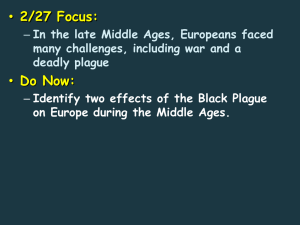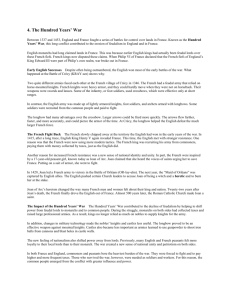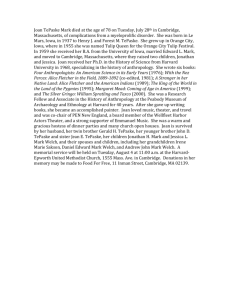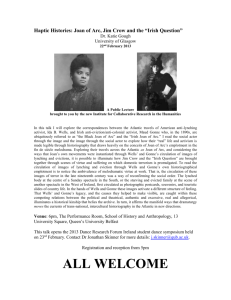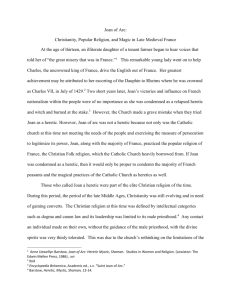Joan of Arc
advertisement
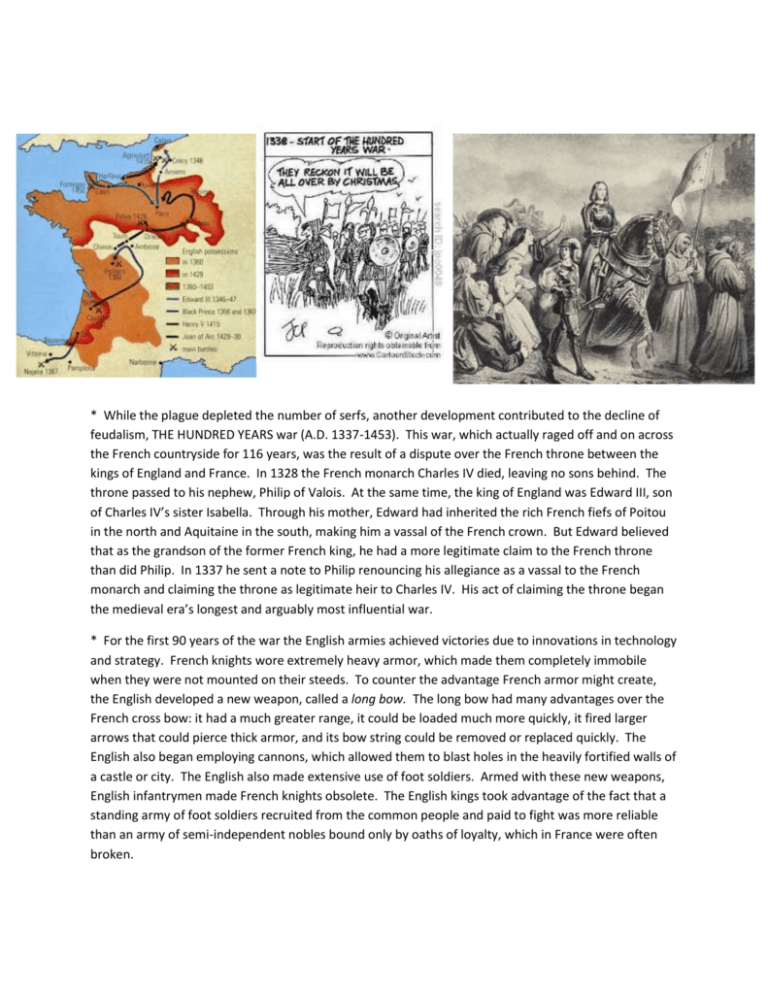
* While the plague depleted the number of serfs, another development contributed to the decline of feudalism, THE HUNDRED YEARS war (A.D. 1337-1453). This war, which actually raged off and on across the French countryside for 116 years, was the result of a dispute over the French throne between the kings of England and France. In 1328 the French monarch Charles IV died, leaving no sons behind. The throne passed to his nephew, Philip of Valois. At the same time, the king of England was Edward III, son of Charles IV’s sister Isabella. Through his mother, Edward had inherited the rich French fiefs of Poitou in the north and Aquitaine in the south, making him a vassal of the French crown. But Edward believed that as the grandson of the former French king, he had a more legitimate claim to the French throne than did Philip. In 1337 he sent a note to Philip renouncing his allegiance as a vassal to the French monarch and claiming the throne as legitimate heir to Charles IV. His act of claiming the throne began the medieval era’s longest and arguably most influential war. * For the first 90 years of the war the English armies achieved victories due to innovations in technology and strategy. French knights wore extremely heavy armor, which made them completely immobile when they were not mounted on their steeds. To counter the advantage French armor might create, the English developed a new weapon, called a long bow. The long bow had many advantages over the French cross bow: it had a much greater range, it could be loaded much more quickly, it fired larger arrows that could pierce thick armor, and its bow string could be removed or replaced quickly. The English also began employing cannons, which allowed them to blast holes in the heavily fortified walls of a castle or city. The English also made extensive use of foot soldiers. Armed with these new weapons, English infantrymen made French knights obsolete. The English kings took advantage of the fact that a standing army of foot soldiers recruited from the common people and paid to fight was more reliable than an army of semi-independent nobles bound only by oaths of loyalty, which in France were often broken. * In 1429, when French fortunes had sunk to their lowest point, Joan of Arc, a young peasant woman, rose to put France on the path to victory. Joan of Arc was born in A.D. 1412, and spent the first 17 years of her life as a shepherd tending her father’s flocks in the Lorraine region of eastern France. At 17, she later claimed, Joan began hearing the voices of Saints Michael, Catherine, and Marguerite each of whom urged her to save France by defeating the English and retaking important cities like Rheims and Paris. In 1429 she traveled to deliver her message to the uncrowned king of France, Prince Charles. Doubting the veracity of her divine mission, the Prince planned to play a trick on Joan. When she appeared at court, Charles put another man on the throne, while he stood among his nobles. But Joan went directly to the Prince, knelt at his feet, and said, “I tell thee, on behalf of the Great Lord, that thou art the true heir of France and the son of the king.” From that point on, Charles supported Joan. In command of an army of 4,000, Joan won her first battle at Orleans, lifting a lengthy English siege by defeating a larger enemy force. After French forces, with Joan in a suit of armor at their head, liberated Rheims, the Prince was crowned Charles VII, king of France, in that city’s famous cathedral, with Joan at his side. The French fortunes had completely changed after just two years of leadership by Joan of Arc. * Despite the fact that Joan’s career ended tragically, her leadership changed the course of the war completely. In early 1431 she was captured by citizens of Burgundy, an independent region of eastern France allied with the English. The Burgundians sold her to the English, who accused her of being a witch. After a five-month trial, in which she ably defended the orthodoxy and sincerity of her faith, Joan was nonetheless found guilty of heresy. On May 30, 1431, she was burned at the stake in the main square of Rouen. Throughout her captivity, the weak Charles VII did nothing to help Joan’s plight. Ironically, it was the charisma of the 19-year-old peasant woman that had not only put Charles on the throne, but had delivered France to the brink of victory. With Joan in armor and riding a war horse as the head of the troops, the French army had pushed the British out of central France and bottled them up on the Atlantic coast. By 1453, 22 years after Joan’s death, France had defeated England. Joan’s faith was finally vindicated centuries later when the Catholic Church made her a saint in 1922. * Developments during the Hundred Years’ War contributed to the downfall of feudalism in France and England. Because of the heroic victories won by Joan of Arc, many French people found themselves at the end of the war with a new sense of patriotism towards their kind and country. Prior to the war, many French commoners had more allegiance to their local lord, and many high-ranking nobles acted practically independently of the king. Before his death in 1483, the French king Louis XI established the absolute rule that had previously eluded the French monarchs. He cemented his right to collect taxes, a practice that had expanded during the war because of the need to finance the army. He reduced the military power of the nobles by enlarging a new standing army that answered only to him. He also implemented an efficient bureaucracy, which implemented new laws regarding taxes, tolls, and commerce, all of which supported the economic prosperity of the middle class and reduced the traditional power of nobles. In England, both the crown and Parliament used the war to gain power. Losing all their French possessions allowed the English monarchs to concentrate more on the running of their country, which in turn increased their influence and prestige in domestic affairs.

